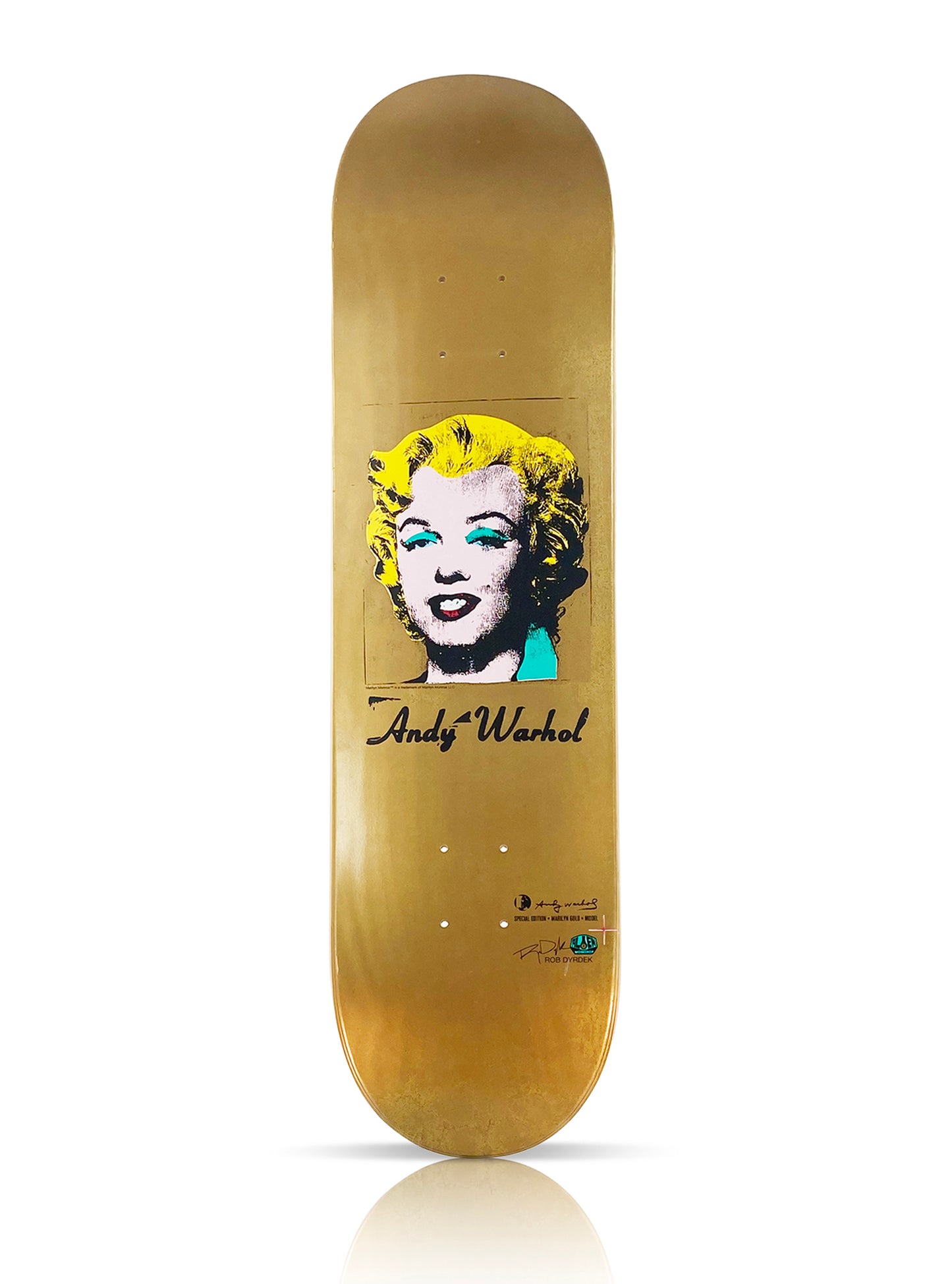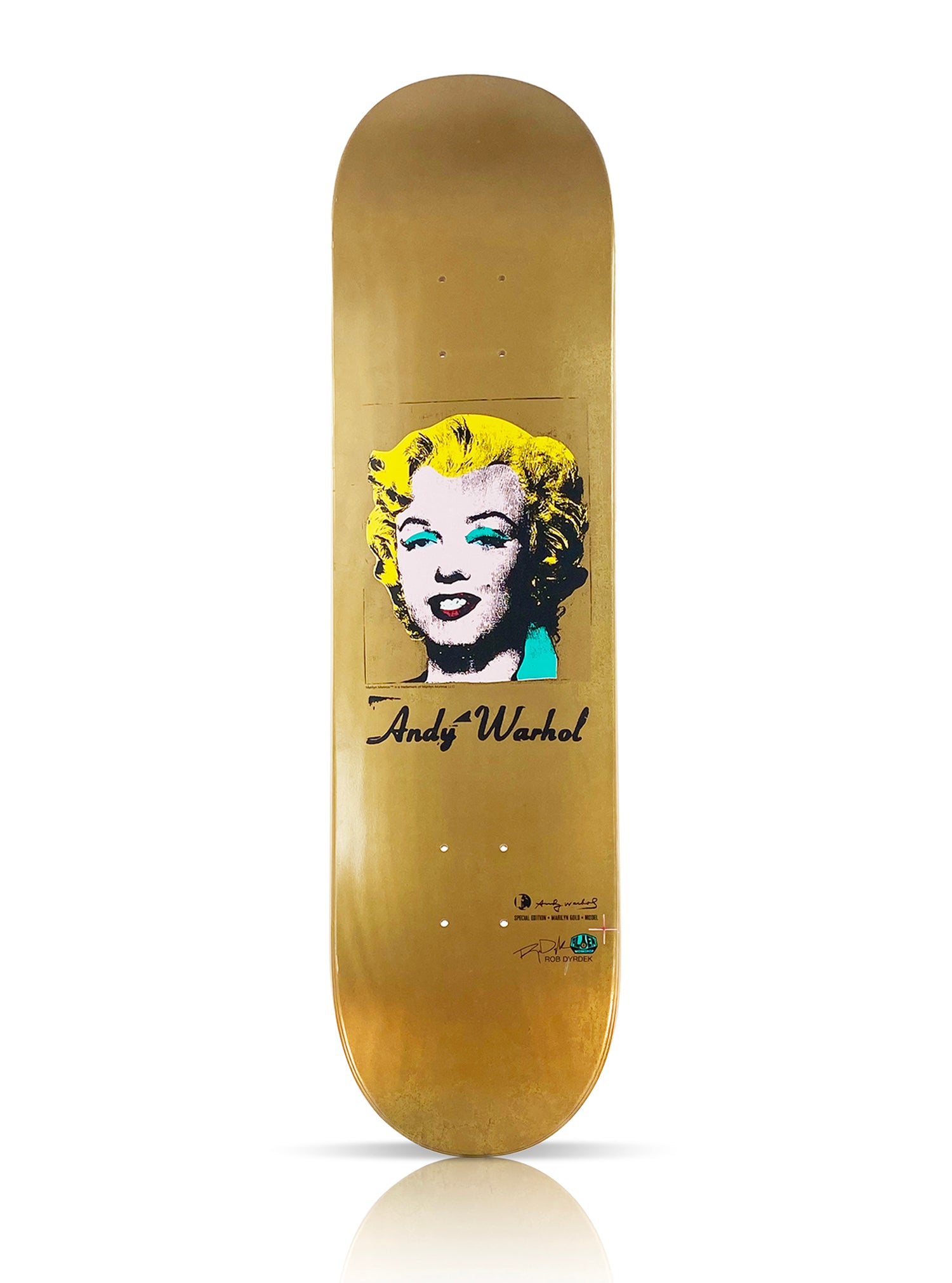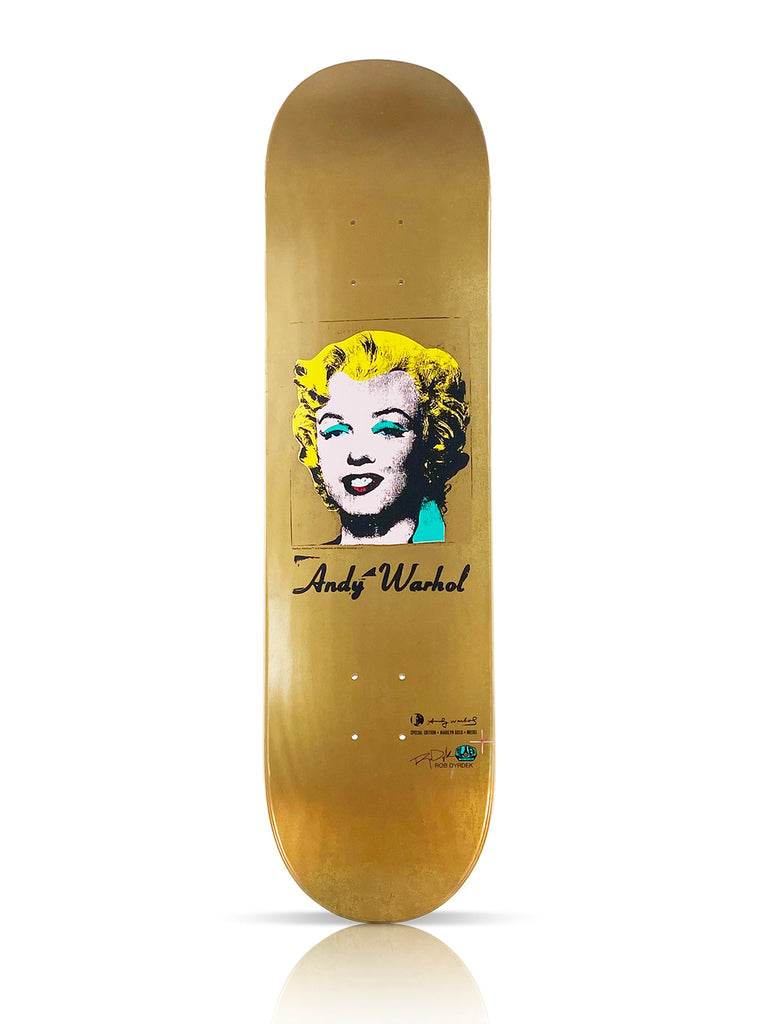Skateoftheart
ANDY WARHOL 'Marilyn Gold' (2011) Skateboard Deck
ANDY WARHOL 'Marilyn Gold' (2011) Skateboard Deck
Couldn't load pickup availability
'Marilyn Gold' by Andy Warhol (after), 2011
Limited Edition Skateboard Deck by Alien Workshop for pro skater Rob Dyrdek.
Officially licensed by the Andy Warhol Foundation.
7.75 x 31.5 Inches
Screen print on 7-ply Canadian Maple hardwood skate deck.
Limited Edition (Sold Out).
New in shrink wrap with Sk8 of the Art COA.
*Note: Skate Deck wall hangers sold separately.
ARTIST BIO
Few historical figures emerge from the blur of the fast-paced 20th century with single-name recognition and notoriety—Kennedy, Elvis, Nixon, Hitler, Jobs, DiMaggio, Marilyn, Churchill—Warhol. Yet Warhol succeeds where few have gone. Arguably, Warhol’s greatest creation is the icon of himself: aloof, spiked, silver-haired icon, bespectacled and adored today.
Warhol’s art embraces the cultural ambiguities of his times and creates an oeuvre of universal nuance, innuendo and contradiction that teases, delights and befuddles both his contemporaries and the following 21st century audiences.
Already lauded by many as the greatest 20th century artist, Warhol transcends his celebrity status, memorialized in tales of his legendary art studio, The Factory, churning out his prolific silk-screen prints, movies, and photographs, by day; and living an audacious New York nightlife with Studio 54-antics, partying with the social elite, celebrities and stars of music, stage and screen.
Warhol succeeds where others have only attempted and failed: his icon is indelibly stamped on the 1960’s as artist, revolutionary and cult leader of the Pop Art movement.
In the 1970s and 80s, Andy Warhol colorfully and masterfully spun his legendary depictions of celebrities, movie stars, athletes and society figures, while simultaneously mastering the social palate of downtown New York as Warhol created print after print of the cultural icons of his time, all the while constructing his public persona and artistic mystique.
Not only do Warhol’s prints of the cultural icons emanate from the most politically-charged, creative and expressive periods of the 20th century, they also convey a contradictory critique on the themes of popular culture, society, celebrity and consumerism that captivated Warhol’s artistic imagination.
Andy Warhol’s iconic, illustrative depictions of consumerism and celebrities from the 1960s-80s may have had a deeper, more personal meaning for the artist. Warhol dealt with issues surrounding his image from a young age – coming from a poor Pittsburg family, persistent health problems and a perpetual lust for all things beautiful – and felt an insatiable drive to reemerge like a Phoenix in a public persona of his own design and creation.
Warhol lived life on the edge and his life and art were pushed, constantly redefining his personal and public boundaries. So strong was his image of himself as an artist, that he sculpted his own face, undergoing plastic surgery, at a time when the surgical practice was still in its preliminary stage and very experimental. Warhol despised his rounded nose, and sought out cosmetic surgery in 1958 at age 29 in 1958, to re-shape his nose and sharpen his profile. His approach to his life was Pygmalion. And his subject was himself. His face was one of his many canvases.
Warhol’s intense fascination with stardom, immortality through celebrity-status and beauty drew him to iconic figures from the one-of-a-kind Marilyn Monroe to the personalities of the political sphere like Jackie Kennedy. Warhol began producing his Marilyn portraits the day of her death in 1962 and his images of Jackie Kennedy were created just days after the assassination of her husband in 1963. As an artist, he keenly perceived social trends and sorted the extraordinary events and personalities from the ordinary. His art was the filter by which he iconically captured the beautiful. As he famously said, “Pop Art is a way of liking things.”
Indeed, the mesmerizing elements of Warhol’s portraits are that they use outrageous colors and polarizing contrasts that take the art from the surface to iconic and then to sublime.
Warhol’s Marilyn images are some of his most well-known and celebrated works. The piece, Marilyn Monroe 31, is one of a series of ten screen prints he created based on a photo taken by Gene Korman for promotional purposes for her 1953 film Niagara.


Don't Forget...
-
GHOST MOUNTS 'Skate Deck Hanger' Acrylic Floating Mount
Regular price $15.00 USDRegular priceUnit price per -
GHOST MOUNTS 'Diptych Skate Deck Hanger' (2x) Acrylic Floating Mount
Regular price $25.00 USDRegular priceUnit price per -
GHOST MOUNTS 'Triptych Skate Deck Hanger' (3x) Acrylic Floating Mount
Regular price $35.00 USDRegular priceUnit price per
Collapsible content
DETAILS
Provide details like specifications, materials, or measurements.
Add an image in your Collapsible content settings for more visual interest.
TIPS
Share expert tips on how to use this product or pair it with other items.
SHIPPING
List the details of your shipping policy.
SUBCRIBE TO OUR EMAILS
Subscribe now to get access to Exclusive New Releases, Inventory
Updates, Access to Artist Proofs, Special Mailing-List-Only deals and
more!








